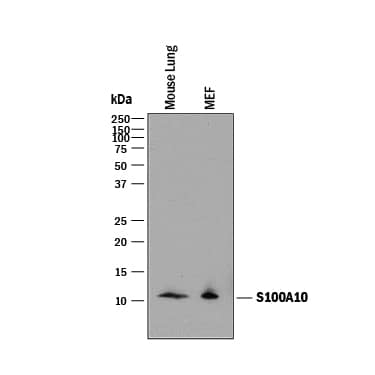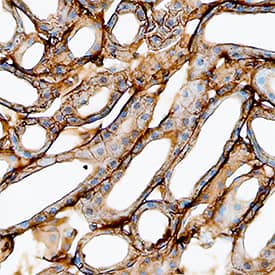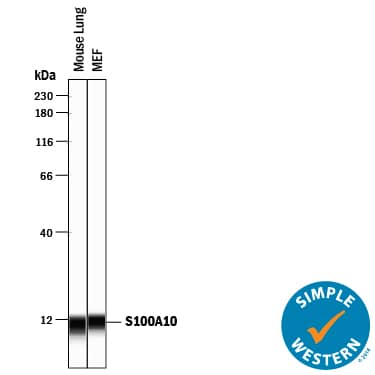Mouse S100A10 Antibody Summary
Pro2-Lys97
Accession # P08207
Applications
Please Note: Optimal dilutions should be determined by each laboratory for each application. General Protocols are available in the Technical Information section on our website.
Scientific Data
 View Larger
View Larger
Detection of Mouse S100A10 by Western Blot. Western blot shows lysates of mouse lung and MEF mouse embryonic feeder cells. PVDF membrane was probed with 0.1 µg/mL of Goat Anti-Mouse S100A10 Antigen Affinity-purified Polyclonal Antibody (Catalog # AF2377) followed by HRP-conjugated Anti-Goat IgG Secondary Antibody (Catalog # HAF017). A specific band was detected for S100A10 at approximately 11 kDa (as indicated). This experiment was conducted under reducing conditions and using Immunoblot Buffer Group 1.
 View Larger
View Larger
S100A10 in Mouse Kidney. S100A10 was detected in perfusion fixed frozen sections of mouse kidney using Goat Anti-Mouse S100A10 Antigen Affinity-purified Polyclonal Antibody (Catalog # AF2377) at 15 µg/mL overnight at 4 °C. Tissue was stained using the Anti-Goat HRP-DAB Cell & Tissue Staining Kit (brown; Catalog # CTS008) and counterstained with hematoxylin (blue). Specific staining was localized to plasma membrane in epithelial cells. View our protocol for Chromogenic IHC Staining of Frozen Tissue Sections.
 View Larger
View Larger
Detection of Mouse S100A10 by Simple WesternTM. Simple Western lane view shows lysates of mouse lung tissue and MEF mouse embryonic feeder cells, loaded at 0.2 mg/mL. A specific band was detected for S100A10 at approximately 11 kDa (as indicated) using 1 µg/mL of Goat Anti-Mouse S100A10 Antigen Affinity-purified Polyclonal Antibody (Catalog # AF2377) followed by 1:50 dilution of HRP-conjugated Anti-Goat IgG Secondary Antibody (Catalog # HAF109). This experiment was conducted under reducing conditions and using the 12-230 kDa separation system.
Reconstitution Calculator
Preparation and Storage
- 12 months from date of receipt, -20 to -70 °C as supplied.
- 1 month, 2 to 8 °C under sterile conditions after reconstitution.
- 6 months, -20 to -70 °C under sterile conditions after reconstitution.
Background: S100A10
S100A10 is a member of the S100 family of EF hand calcium-binding proteins. It is primarily found in mast cells as well as heterotetrameric complexes (two annexin A2 subunits and two S100 A10 subunits) that are present intracellularly at the plasma membrane or on the extracellular cell surface. Extracellular S100A10 is a key plasminogen receptor that plays an important role in cellular plasmin production and cellular invasiveness.
Product Datasheets
Citations for Mouse S100A10 Antibody
R&D Systems personnel manually curate a database that contains references using R&D Systems products. The data collected includes not only links to publications in PubMed, but also provides information about sample types, species, and experimental conditions.
20
Citations: Showing 1 - 10
Filter your results:
Filter by:
-
Sp1-regulated expression of p11 contributes to motor neuron degeneration by membrane insertion of TASK1
Authors: Victoria García-Morales, Guillermo Rodríguez-Bey, Laura Gómez-Pérez, Germán Domínguez-Vías, David González-Forero, Federico Portillo et al.
Nature Communications
-
Annexin A2 supports pulmonary microvascular integrity by linking vascular endothelial cadherin and protein tyrosine phosphatases
Authors: Luo M, Flood EC, Almeida D et al.
J. Exp. Med.
-
Blocking C3d+/GFAP+ A1 Astrocyte Conversion with Semaglutide Attenuates Blood-Brain Barrier Disruption in Mice after Ischemic Stroke
Authors: Qi Zhang, Chang Liu, Rubing Shi, Shiyi Zhou, Huimin Shan, Lidong Deng et al.
Aging and disease
-
AP-1 controls the p11-dependent antidepressant response
Authors: RU Chottekala, S Kalik, J Gresack, A Ayala, M Gao, W Wang, S Meller, A Aly, A Schaefer, P Greengard
Mol. Psychiatry, 2020-05-21;0(0):.
-
Cell- and region-specific expression of depression-related protein p11 (S100a10) in the brain
Authors: Ana Milosevic, Thomas Liebmann, Margarete Knudsen, Nicoletta Schintu, Per Svenningsson, Paul Greengard
Journal of Comparative Neurology
-
Effect of rottlerin on astrocyte phenotype polarization after trimethyltin insult in the dentate gyrus of mice
Authors: Y Hwang, HC Kim, EJ Shin
Journal of Neuroinflammation, 2022-06-11;19(1):142.
Species: Mouse
Sample Types: Whole Tissue
Applications: IHC -
Inhibition of the NLRP3-inflammasome prevents cognitive deficits in experimental autoimmune encephalomyelitis mice via the alteration of astrocyte phenotype
Authors: B Hou, Y Zhang, P Liang, Y He, B Peng, W Liu, S Han, J Yin, X He
Cell Death Dis, 2020-05-15;11(5):377.
Species: Mouse
Sample Types: Tissue Homogenates
Applications: Western Blot -
Neuroprotective efficacy of different levels of high-frequency repetitive transcranial magnetic stimulation in mice with CUMS-induced depression: Involvement of the p11/BDNF/Homer1a signaling pathway
Authors: C Zuo, H Cao, F Ding, J Zhao, Y Huang, G Li, S Huang, H Jiang, Y Jiang, F Wang
J Psychiatr Res, 2020-04-05;125(0):152-163.
Species: Mouse
Sample Types: Tissue Homogenates
Applications: Western Blot -
PSA-NCAM colocalized with cholecystokinin-expressing cells in the hippocampus is involved in mediating antidepressant efficacy
Authors: J Yamada, C Sato, K Konno, M Watanabe, S Jinno
J. Neurosci., 2019-12-04;0(0):.
Species: Mouse
Sample Types: Whole Tissue
Applications: IHC -
Mapping the physiological and molecular markers of stress and SSRI antidepressant treatment in S100a10 corticostriatal neurons
Authors: D Sargin, RU Chottekala, KE Perit, V Yao, D Chu, DW Sparks, S Kalik, SK Power, OG Troyanskay, EF Schmidt, P Greengard, EK Lambe
Mol. Psychiatry, 2019-08-20;25(5):1112-1129.
Species: Mouse
Sample Types: WholeTissue
Applications: IHC -
P11 Loss-of-Function is Associated with Decreased Cell Proliferation and Neurobehavioral Disorders in Mice
Authors: G Liu, Y Wang, W Zheng, H Cheng, R Zhou
Int. J. Biol. Sci., 2019-05-20;15(7):1383-1395.
Species: Mouse
Sample Types: Cell Lysates
Applications: Western Blot -
Ahnak scaffolds p11/Anxa2 complex and L-type voltage-gated calcium channel and modulates depressive behavior
Authors: J Jin, DL Bhatti, KW Lee, L Medrihan, J Cheng, J Wei, P Zhong, Z Yan, C Kooiker, C Song, JH Ahn, GJ Obermair, A Lee, J Gresack, P Greengard, Y Kim
Mol. Psychiatry, 2019-02-13;0(0):.
Species: Mouse
Sample Types: Tissue Homogenates
Applications: Western Blot -
Gestational stress in mouse dams negatively affects gestation and postpartum hippocampal BDNF and P11 protein levels
Authors: T Vanmierlo, J De Vry, E Nelissen, A Sierksma, N Roumans, HWM Steinbusch, LP Wennogle, D van den Ho, J Prickaerts
Mol. Cell. Neurosci., 2018-02-28;0(0):.
Species: Mouse
Sample Types: Whole Tissue
Applications: IHC-F -
Molecular codes for cell type specification in Brn3 retinal ganglion cells
Authors: S Sajgo, MG Ghinia, M Brooks, F Kretschmer, K Chuang, S Hiriyanna, Z Wu, O Popescu, TC Badea
Proc. Natl. Acad. Sci. U.S.A., 2017-05-02;0(0):.
Species: Mouse
Sample Types: Whole Tissue
Applications: IHC -
Identification of the cortical neurons that mediate antidepressant responses.
Authors: Schmidt EF, Warner-Schmidt JL, Otopalik BG, Pickett SB, Greengard P, Heintz N
Cell, 2012-05-25;149(5):1152-63.
Species: Mouse
Sample Types: Whole Tissue
Applications: IHC -
Characterization of S100A11, a suppressive factor of fertilization, in the mouse female reproductive tract.
Authors: Hanaue M, Miwa N, Uebi T, Fukuda Y, Katagiri Y, Takamatsu K
Mol. Reprod. Dev., 2011-01-20;78(2):91-103.
Species: Mouse
Sample Types: Tissue Homogenates
Applications: Western Blot -
Role of p11 in cellular and behavioral effects of 5-HT4 receptor stimulation.
Authors: Warner-Schmidt JL, Flajolet M, Maller A, Chen EY, Qi H, Svenningsson P, Greengard P
J. Neurosci., 2009-02-11;29(6):1937-46.
Species: Mouse
Sample Types: Cell Lysates, Whole Tissue
Applications: IHC, Western Blot -
p11 modulates calcium handling through 5-HT4R pathway in rat ventricular cardiomyocytes
Authors: Pierre Meschin, Marie Demion, Olivier Cazorla, Amanda Finan, Jérôme Thireau, Sylvain Richard et al.
Cell Calcium
-
Reversal of Depressed Behaviors in Mice by p11 Gene Therapy in the Nucleus Accumbens
Authors: Brian Alexander, Jennifer Warner-Schmidt, Therese Eriksson, Carol Tamminga, Margarita Arango-Lievano, Margarita Arango-Llievano et al.
Science Translational Medicine
-
p11 in Cholinergic Interneurons of the Nucleus Accumbens Is Essential for Dopamine Responses to Rewarding Stimuli
Authors: Y. Hanada, Y. Kawahara, Y. N. Ohnishi, T. Shuto, M. Kuroiwa, N. Sotogaku et al.
eNeuro
FAQs
No product specific FAQs exist for this product, however you may
View all Antibody FAQsReviews for Mouse S100A10 Antibody
There are currently no reviews for this product. Be the first to review Mouse S100A10 Antibody and earn rewards!
Have you used Mouse S100A10 Antibody?
Submit a review and receive an Amazon gift card.
$25/€18/£15/$25CAN/¥75 Yuan/¥1250 Yen for a review with an image
$10/€7/£6/$10 CAD/¥70 Yuan/¥1110 Yen for a review without an image

